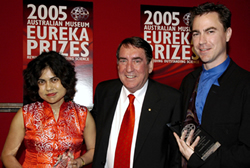|
|
|||
|
|
|||
 |
|
|
University of New South Wales Eureka Prize for Scientific Research$10,000Waste plastic makes steelFrom landfill nuisance to carbon for steel making Professor Veena Sahajwalla, Professor Mark Wainwright and Dr Peter Tuthill. Photo: Stuart Humpreys © Australian Museum. Veena Sahajwalla has shown the steel industry that they can use waste plastic bottles to make steel. The plastic replaces coal as a source of carbon in the steel-making process. It's been a hard sell in a conservative industry, but now steel-makers around the world are picking up her ideas. She expects to see the technology in use in Australia and the US within two years. Her achievement wins the $10,000 University of New South Wales Eureka Prize for Scientific Research. Sahajwalla is Director of Sustainable Materials Processing Research at the University of New South Wales. Forty per cent of the world's steel is produced in electric arc furnaces operating at 1600 ° C. "Up to 30% of the coal in these furnaces can be replaced with recycled plastic and we are aiming for more," says Sahajwalla. "Not only does the plastic replace coal as a carbon source, it also acts as a fuel, reducing the power requirements for the furnace, and the extreme temperatures of steelmaking eliminate pollutants like dioxins." "In Australia, we consume more than one million tonnes of plastic each year. Eighty per cent is incinerated or becomes landfill. So plastic waste remains a major environmental concern," she says. Sahajwalla is collaborating with leading steel producers in Australia and the United States. She says they are excited about the potential of the process. "We are currently testing mixtures of waste plastics, and we hope to implement our technology in the steel industry in Australia and the United States within the next two years." "Veena Sahajwalla's work is solving two environmental problems at once," says Frank Howarth, Director of the Australian Museum. "She is a joint winner of the $10,000 University of New South Wales Eureka Prize for Scientific Research, sharing the prize with University of Sydney astrophysicist Peter Tuthill. Tuthill has captured unique infra-red images of the life and death of stars using a 130-year old technique." This Prize is awarded for outstanding curiosity-driven scientific research, undertaken in Australia by an Australian scientist under the age of 40. It is sponsored by the University of New South Wales. Seeing life and death amongst the stars130-year-old technology beats the HubbleSydney astrophysicist Dr Peter Tuthill has produced the best ever infra-red images of life and death among the stars. His achievement has won him the $10,000 University of New South Wales Eureka Prize for Scientific Research for his redevelopment of a 130-year-old photographic technique known as aperture masking. "The technique has yielded spectacular images," Tuthill says. "These images have given us the first ever high-resolution pictures of baby stars, dying stars and strange spiral pinwheels in Wolf-Rayet systems. These binary stars are typically 3 times the size and 25 times heavier than our sun, and would outshine it by a factor of 100,000. Wolf-Rayet stars are so bright that they are literally flying apart!" The technique used by Tuthill involves placing a holey metal plate over the eye of a telescope. This cuts dramatically the total amount of light the telescope receives, but allows it to make sharper images what it can see. The resolution of images produced is the equivalent of being able to see a five-cent coin clearly from 100 kilometres away. "The crucial phases of a star's birth and death take place in clouds of dust and gas as big as our solar system. Using near-infrared observations we can penetrate through the layers of obscuring dust to reveal the hot, bright, interesting regions at the core," says Dr Tuthill, Australian Research Fellow at the Department of Physics, Sydney University. Turbulent motion of air in our atmosphere makes stars shimmer and difficult to resolve to fine detail. The aperture masking solution used by Tuthill was first proposed by French optician Fizeau in 1868. In recent years, attempts to solve the shimmer problem have focused instead on high-tech adaptive optics using intensive and expensive computing power. Tuthill's approach, by comparison, has delivered the highest resolution infrared images yet attained, but on a shoestring budget. He says the technique has helped established ground rules for a new generation of individual small telescopes - that will be linked together to give clearer images from the ground. "They will never replace space telescopes, but in niche areas they will be able to outperform them, and may inform the design of future space telescopes," he says. The $10,000 University of New South Wales Eureka Prize for Scientific Research has been awarded jointly to his work in astrophysics and to the work of Professor Veena Sahajwalla on using waste plastics in steelmaking. The Prize is awarded for outstanding curiosity-driven scientific research, undertaken by an Australian scientist under the age of 40. Further information: http://www.physics.usyd.edu.au/~gekko/
|
|
|
|||
|
|
|||